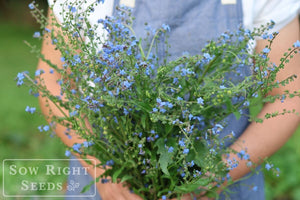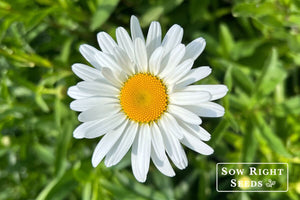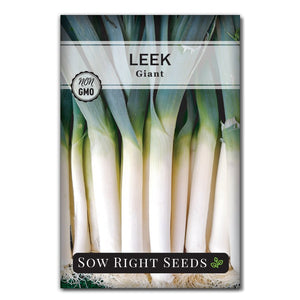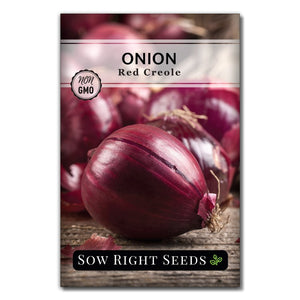The Expert Methods for Growing Leeks Perfectly Every Time
OnionsMy first introduction to leeks was in a box delivered by a local farm-to-door subscription. I immediately looked up recipes to see what to do with these beautiful vegetables that looked like giant green onions. Once I learned how to wash them and cook them in a delicious leek and potato soup, I wanted to grow them. Luckily for me, they're not that hard to grow. Follow these expert tips and discover how easy it is to grow leeks from seed.

Leeks are part of the Allium family and have similar characteristics, but they have their own unique flavor and growing requirements.
Instead of a bulb, leeks have a long white shaft that is the main edible part.
This is the crucial place where growing onions and leeks diverge.
Unlike bulb onions, you can plant leeks deep and add mulch around the stems. The white part of leeks is more tender and is the part used in cooking. Most of the white stalk grows underground.
Planting leeks from seed is simple and will give you control over when to place them outside for optimal growth. Once you understand the “deep” secret about growing leeks, you’ll be a pro in no time.
How to Grow Leeks from Seed
Leeks can be started from seed the same way as bulb onions. You can direct sow leek seeds outdoors or start seeds indoors. Seeds can be sown in separate seed plugs or close together in trays and then separated for transplanting.
Leeks can be started indoors 8 to 10 weeks before the last frost date or direct sown when the soil is around 55 to 65º F. We recommend starting leek seeds indoors, where you can start them early and monitor their growth until it’s time to transplant.

Leek Seed Germination Tips (Indoor Seed Starting)
Use moist seed starting mix
Plant leek seeds about 1 inch apart and ¼” deep
Keep seeds warm and moist to germinate quickly (70ºF)
Seeds should sprout in 5 - 10 days.
Once seeds have sprouted, water from the bottom and keep the soil moist
Use a grow light to give them adequate light (12 to 16 hours)
We start many of our seeds indoors to gain more control over germination and seedling viability. The added benefit of starting leeks indoors is that you can transplant the seedlings deep to develop the long, white, tender part that is the most edible.

Transplanting Leeks
Leek seedlings are ready to transplant when they are 8 to 10 inches tall and almost as thick as a pencil. Before transplanting, acclimate the seedlings to outdoor conditions. Harden them off slowly over a week or so by setting them outside for one hour and increasing the time by an hour each day.
Once they have been hardened off, transplant leek seedlings after all danger of frost has passed. Mature leeks are frost tolerant, but seedlings are not.
Leek seeds planted close together in trays may require extra care to untangle their roots. Washing away the soil can help loosen the roots for easier separation.
Plant leek seedlings 6” apart. This may seem like a lot of space for a narrow leek, but the green leaves need room to spread.
You can plant leeks deep, and they will develop a long white shaft. There are two methods you can use for transplanting leeks.
Method 1 - Use a hand trowel or the handle of a hoe to make 6-8” deep holes. Place one seedling in each hole, being careful to get the roots to the bottom of the hole. Only 2 inches or so of the green top needs to be above ground.
Method 2: Dig a trench 6-8” deep and place the leeks 6” apart.
Now, this part of transplanting leeks is where you want to pay attention! Do not fill in the holes or the trench! That may be hard to resist. When transplanting trees and other plants, you want to tamp the soil down and not have any air pockets. But leeks are different. You want them to be able to expand without any soil pressure as they grow.
Once you have placed the leek seedlings in the hole or trench, water them well. The soil will naturally fill in around the plants; you don’t need to add soil or press it down. If the soil is too compacted, there will be more pressure, making it harder for the plants to grow big.
Growing Leeks
Sun
Leeks grow best in full sun, which means at least 6 hours of direct sunlight daily. They can tolerate shade but need lots of sun to grow to their maximum size. Eight to ten hours of sunlight is ideal.
Soil
The best soil for growing leeks is fertile, well-draining, alkaline soil with a pH between 6.0 and 7.0. Leeks need loose soil that allows the deeply planted shaft to expand easily as it grows. You will need to amend heavy clay soil, with well-rotted compost before planting.
Water
Fertilizer

Hilling and Blanching
The white shaft of leeks is the most edible part. Hilling or blanching prevents this part of the leek from being exposed to sunlight so that it will remain white.
Hilling is the process of adding more dirt around the leek plant as it grows. Several times during the growing season, you can add 2 or 3 inches of soil. This method keeps the leeks white, which is called blanching.
To blanch without dirt, you can tie paper tubes around the stems several weeks before harvesting. This method has the advantage of reducing dirt in the layers of leaves.
Planting leek seedlings 6 to 8 inches deep to begin with is also important for growing long white leeks. The part grown underground will remain white without any additional hilling.

Harvesting Leeks
Leeks take anywhere from 90 to 120 days to reach a mature size. You can harvest at any time, which makes them a versatile crop. Leeks are most often harvested when they are at least 1 inch in diameter.
You want to make sure to harvest leeks before they start to flower. Once they start flowering, they become less tender, and the flavor changes.
To harvest leeks, use a pitchfork or shovel to dig straight down without hitting the plant. Then, loosen the soil to pull up the leek. Wipe off the soil and trim roots off right at the base. You can also chop off the top inches of green as well. Wait until you’re ready to eat them before washing them with water.
Leeks can be full of soil and need to be washed well before eating. There are several ways to clean them.
One method is to do a surface rinse before chopping them. Once the leeks are chopped, place the pieces into a bowl of water and swish them around to let the dirt fall off and sink to the bottom. Lift out the leek pieces and place them in a salad spinner. Rinse again and then spin to remove extra water.
Another leek cleaning method focuses on keeping the pieces larger. Slice off the root end and the top green part. Then, slice the whole leek in half lengthwise. Hold the half under running water and massage the leaves to allow the water to run through the many layers.
In mild climates, leeks planted in late summer can be overwintered and harvested throughout the winter.
Harvested leeks can be stored in the fridge for a week or so.
Companion planting
Pests & Diseases
While leeks are generally easy to grow, some pests and diseases can appear. Thrips, onion maggots, and wireworms are common pests. Rotating crops can help limit infestation. If needed, neem oil spray and other organic solutions can be applied.

Leek FAQs
When can you plant leeks?
Leeks can be planted in the fall or spring. In locations with mild winters, leeks can be grown year-round. Leeks are a cool weather crop that grows best in temperatures between 45 and 75ºF.
When do you harvest leeks?
Generally, leeks are harvested when they are larger than 1 inch in diameter. Depending on your growing season, this could be in the summer or winter.
Leeks vs Green Onions?
Visually, green onions seem very similar to leeks. However, leeks are grown very differently and have a different taste and texture.
Green onions have tender greens while leek greens are tough.
Leeks are a beautiful crop in the garden with their big fan of leaves. You can even add them to a flower or herb bed for their visual interest. They will eventually flower and go to seed when left to grow for over a year. The puffy flowerhead looks like an explosion of fireworks and will attract beneficial pollinators to your garden.
Now that you know the secrets for growing leeks from seed, plant them deep and enjoy their unique and delicious flavor. Don’t miss out on this plant in your vegetable garden.
Written by Beverly Laudie








Very good enjoyable article on the art of leek growing. Growing up in Northumberland UK, leeks were grown in most veg patches. But the real dark art of growing show leeks were kept within families.
I have a gold medal won by my grandfather Thomas Horsley for champion leeks at Netherton Colliery in the 1800’s.
Unfortunately he died before I was born, so no secret method for me, but granny grew leeks to be proud of.
What memories this article brought to mind.
.
Leave a comment